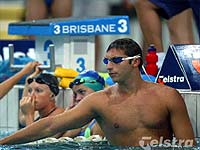THE SECRET OF Ian Thorpe's blistering speed
THE SECRET OF Ian Thorpe's blistering speed
SPORT scientists are close to uncovering the secret of Ian Thorpe's blistering speed. Dr Bruce Mason, head biomechanist with the Australian swimming team, said on the 21st March 2002 "the Thorpedo" was so fast he literally surfed the waves he made in the pool. But Mason admitted scientists were at a loss to explain precisely how Thorpe was able to propel himself so efficiently through the water. 
"You've got in Ian Thorpe a swimmer capable of reaching a certain velocity, who produces a more pronounced wave (directly in front of him) than anyone else," Mason said. "Everyone uses their own wave to some degree, but because Ian can get up to the speeds he can, he utilises it far more effectively."

Thorpe's coach Doug Frost admitted yesterday scientists were on the right track but refused to divulge the secret of the most efficient human aquatic propulsion system in history. "I'm going to write a book on it one day and make a million," said Frost with a laugh when asked to explain the "X factor" in Thorpe's stroke.

Yet Frost's warning yesterday that Thorpe's 100m and 200m freestyle times would "develop dramatically over the next few years" may well have been a hint that as the 19-year-old develops physically, his bow wave and the wave that builds between his hips and his feet will actually get bigger and become easier for him to ride. Senior Australian coaches studying Thorpe closely have identified he sits on the two waves and is able to surf them, but seemingly only when he is swimming at 100 per cent capacity. Importantly, Thorpe does not stroke through his own bow wave, but over the top of it, much as a bodysurfer keeping himself in front of a breaker. "As for the wave generated by his kick, you could ride a surfboard on it," said one coach. During the 200m freestyle final on Tuesday, Thorpe's velocity peaked at 1.97m per second and averaged 1.83 per second during the race.
Mason said that as early as 1988, scientists studying East German swimmer Silke Horner discovered breaststrokers were able to accelerate through the water when both their hands and legs were in the recovery phase and they were not doing anything to propel themselves forward. "Inertia doesn't explain it," Mason said. "Inertia with minimal drag would just keep them moving forward at the same speed, but they actually accelerate. The answer is that they are riding their own wave." Now Thorpe seems to be showing it can also apply to freestyle.
"It may just be confined to males, but we just don't know," Mason said, referring to the power and velocity required for the wave-riding phenomenon. "We can't explain by the actions they do why our top swimmers are able to move through the water so much faster than recreational swimmers, but Ian is the ultimate. "To understand it fully, Ian would have to agree to take part in a study, and I can understand that he would not want to do anything that would detract from his future."